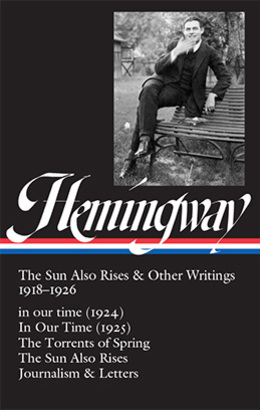A crucial figure in twentieth-century literature finally arrives in the Library of America series with Ernest Hemingway: The Sun Also Rises & Other Writings 1918–1926, which collects the iconic author’s seminal early fiction in authoritative, newly edited texts, along with selections of his journalism and personal correspondence.
Spanning the period that begins with Hemingway’s service as an ambulance driver on the Italian front during World War I and culminates in his mainstream breakthrough novel The Sun Also Rises, LOA’s inaugural Hemingway volume showcases the development of the innovative, deceptively simple prose style in which “the weight of everything that is left unsaid” becomes centrally important.
The book’s editor is Robert W. Trogdon, professor of English at Kent State University. A scholar of twentieth-century American literature and textual editing, he has published extensively on Hemingway and served as an editor for The Cambridge Edition of the Letters of Ernest Hemingway. Via email, Trogdon answered our questions about Hemingway’s creative growth in these years and explained how judicious corrections restore the works closer to what Hemingway originally wrote.
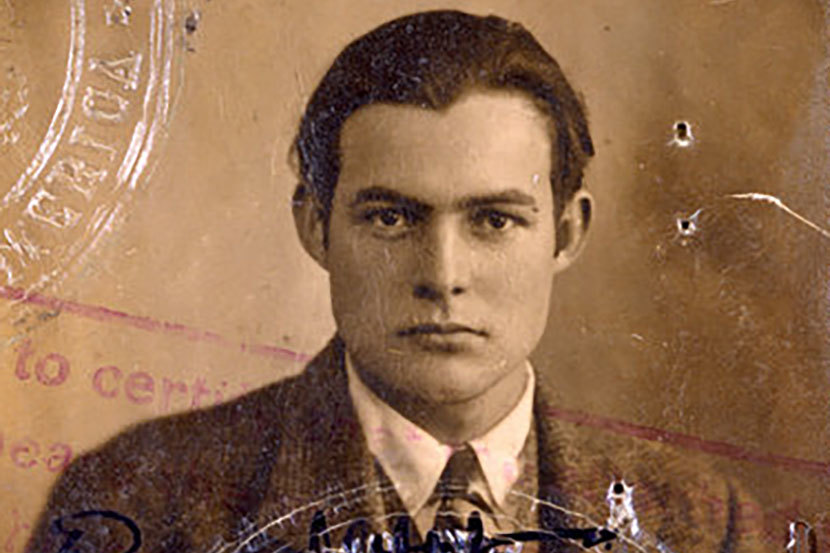
Library of America: This volume covers the period from 1918 to 1926, including the time in Paris and the publication of his astounding 1925 collection In Our Time. Can you describe for our readers this avant-garde literary world of the Left Bank—and Hemingway’s place in it. What does Paris mean to Hemingway? And how does the jump to mainstream publishing come about?
Robert W. Trogdon: Paris in the 1920s provided American writers such as Gertrude Stein, Robert MacAlmon, and Djuna Barnes with greater artistic and personal freedom than they could have experienced in the United States. The favorable exchange rate meant that it was cheaper to live in Paris. There was no Prohibition. And Europe was more open to artistic experimentation than mainstream America was. Many of these writers could and did establish their own presses and little magazines to publish their work and the works of their friends. Without The Little Review and Sylvia Beach, it is doubtful that James Joyce’s Ulysses would have been published.
At first, Hemingway saw himself as a bit superior to these artists. In one of his Toronto Star pieces from 1922, he said that the “scum” of Greenwich Village had been deposited in Paris. But with Stein he found a mentor who taught him about modern art and modern writing. Through Ezra Pound, he was introduced to editors and publishers like Margaret Anderson and Jane Heap of The Little Review, Ford Madox Ford of The Transatlantic Review, and Bill Bird of the Three Mountains Press. They published the stories that he could not place in American magazines.
But Hemingway’s aim was always to publish in America with a mainstream press. By September 1924 he had enough stories for his friend the American humorist Donald Ogden Stewart to try to place. Boni & Liveright eventually accepted the collection due to the support given to it by Sherwood Anderson and Harold Loeb, the model for Robert Cohn in The Sun Also Rises. Before this, F. Scott Fitzgerald had read in our time and recommended that his editor, Maxwell Perkins at Charles Scribner’s Sons, attempt to sign Hemingway. So even though few people would see these works published in Paris, the right people did.
LOA: The 1924 Three Mountains Press edition of in our time partly overlaps with the longer 1925 In Our Time. Why did you choose to include it in this volume? Would you say something about the startling imagery in that short book—and about the pervasive violence readers encounter in its pages?
Trogdon: The period in which Hemingway was writing these vignettes was incredibly violent: World War I, other smaller wars, and political upheaval in both Europe and the United States. Hemingway was mirroring the world he saw around him. In Death in the Afternoon, his bullfighting book from 1932, Hemingway notes that he went to see the bullfights in Spain first as a way to learn how to write: “I was trying to learn to write, commencing with the simplest things, and one of the simplest things of all and the most fundamental is violent death.” In a way, these short works were Hemingway’s attempt to slow the action and to see how he could distill a story down to its essentials. One of my favorite interstitial chapters in In Our Time is the shooting of the two cigar store robbers: the police shot two unarmed Hungarians who are backing out of an alley and justify it because they are “wops,” i.e., Italians. In a way, putting most of these in between the stories in the 1925 collection emphasizes the quieter violence that is in the stories. Most of those don’t depict violence as directly (or they depict emotional violence). I think the vignettes condition the reader to notice the implicit violence in the short stories.
LOA: The stories in the 1925 In Our Time are marked by stylistic innovation and the economy of language we associate with Hemingway, in which the reader feels the weight of everything that is left unsaid. Hemingway is still a very young person when he publishes In Our Time, but many of the stories in that collection are masterpieces—as good as any of the later stories. Where does a story like “Cat in the Rain” or “Big Two-Hearted River” come from?
Trogdon: Hemingway had been writing fiction since high school and had been a working journalist for both the Kansas City Star and the Toronto Star before coming to Paris. So while his output from 1923 and 1924 is amazing (the Hemingway scholar Paul Smith rightly dubbed 1924 a miraculous year for him) his years of apprenticeship helped shape his work. So many of the In Our Time stories have their basis in Hemingway’s past. He was able to rework his biography into fiction. In A Moveable Feast he describes it as a type of “transplanting” where he attempted to recreate in his writing the Michigan he had known. “Big Two-Hearted River” is based on a trip he took in 1919 to the Upper Peninsula of Michigan, but he removed the two companions who were with him to focus wholly on Nick Adams, his fictional avatar. “Cat in the Rain” was based on his and Hadley Hemingway’s trip to Rapallo, Italy, to visit Ezra Pound in 1923. What Hemingway learned to do is pare down his work through successive drafts. He had a tendency to include too much detail in his early drafts that he cut out during his editing process.
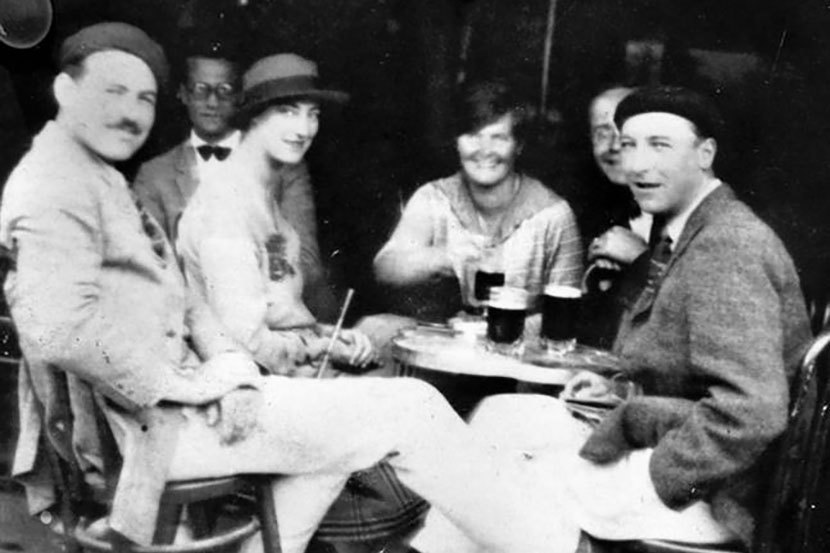
LOA: Tell our readers something about the newly edited, corrected texts you prepared for the Library of America volume. How do these new texts change the way readers may experience Hemingway’s books? Particularly, what about the famous last sentence of The Sun Also Rises? The end punctuation in the Library of America text ends with a period rather than a question mark: “Isn’t it pretty to think so.” Why make this change? Is that how Hemingway wrote the sentence?
Trogdon: The characters in The Sun Also Rises are based on real people. Max Perkins objected to references or allusions to some, like Glenway Wescott and Henry James, that Hemingway had included. This obscured Hemingway’s intention—I always hated having to explain that “Henry’s bicycle” was a reference to “Henry James’s bicycle” when teaching the novel. The change was made at the publisher’s insistence for propriety’s sake, or fears of libel, not for any artistic reason. I followed what Hemingway wrote in his manuscript and in his typescript. As to the punctuation, the editors of Charles Scribner’s Sons were following their standard practice: questions ended with a question mark. They did not make any distinction between real questions and rhetorical questions. But the distinctions we make now were not hard and fast at the time. Many guides to grammar and punctuation of the first part of the twentieth century advise against using question marks for rhetorical questions. Both the manuscript and the typescript of the novel lack the question mark for this and other rhetorical questions in the text. I simply followed the two versions that were under Hemingway’s complete control.
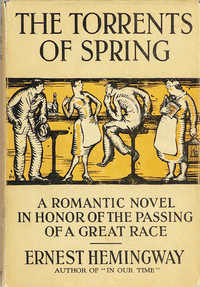
LOA: In his 1964 critical study Waiting for the End, Leslie Fiedler argues that Hemingway’s satirical novel The Torrents of Spring is a key work that helps elucidate his entire oeuvre. What are we to make of the book now, when the source texts Hemingway is parodying are likely to be unfamiliar to anyone who reads it? How do you see The Torrents of Spring in terms of Hemingway’s career?
Trogdon: The Torrents of Spring is almost the forgotten book of Hemingway. In it Hemingway is belittling the pretensions of Lost Generation Paris. Rightfully, we consider it a magical time for modern literature, but not all of the experiments paid off. Hemingway in a letter to F. Scott Fitzgerald in 1928 said that their editor Max Perkins had compared Fitzgerald’s work habits to James Joyce: “Have you gone in for not making sense?” While Hemingway admired some things about Joyce and Gertrude Stein, I don’t think he was totally convinced by some of their experiments. For Hemingway, the first thing a reader had to do was to be able to read the work. He was essentially a social realist, not a high modernist like Joyce, Stein, and Ezra Pound. That is what Torrents is an attack on. I don’t know if it is necessary to read Sherwood Anderson’s novels Dark Laughter or Many Marriages to “get” Hemingway’s parody, but I think most people ought to read Anderson’s short stories, especially Winesburg, Ohio (available in a nice volume from Library of America, I will note).
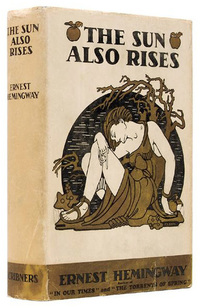
LOA: The Sun Also Rises has two epigraphs—one of them is Ecclesiastes, which gives its title to the novel, and the other is Gertrude Stein’s remark “You are all a lost generation.” The Sun Also Rises establishes Hemingway as the preeminent voice of the Lost Generation. What does Hemingway capture about his generation—and do you think the novel still resonates today with younger readers?
Trogdon: In “A Génération Perdue” in A Moveable Feast—in which he reworked an abandoned preface for The Sun Also Rises—Hemingway wrote that “all generations were lost by something and always had been and always would be” and that the “lost generation” was a dirty and easy label. But he does capture the way his generation and I suppose anyone who is a young adult feels after they leave home. A word that comes up over and over in the novel is “values.” Jake and the other characters are learning, through experience, what they value and what things they are willing to give up for these new values. That is something that we all have to go through whether we are in Paris the 1920s or Peoria in the 2020s.
LOA: No small part of Hemingway’s appeal and mystique had to do with his carefully constructed public persona, which was emphatically masculine. How do contemporary readers feel about Hemingway’s masculinity as it comes across in the novels and stories?
Trogdon: Hemingway did cultivate this view of himself and his work in the 1950s, but he had ample help in the newspapers and magazines of the time. But at least since the publication of his novel The Garden of Eden in 1986, a different view of Hemingway has developed among readers. Many of his early stories, “Up in Michigan” and “Cat in the Rain” in particular, display a male writer who was capable of creating sympathetic and fully developed female characters. I think the careful reader understands the subtleties in Hemingway’s character both as a person and a writer. I find more students picking up on these aspects of his work now then I did twenty years ago. Very few of them want to pursue the blood sports that he was attracted to, but they want to read him for the complexities he was able to capture about human life.
LOA: Library of America’s collection includes generous selections of Hemingway’s personal correspondence from these eight years. What does this material add to our understanding of him, both as a person and a writer? Were you conscious of a need to present a comprehensive “warts and all” portrait of this major twentieth-century writer?
Trogdon: In my academic career, there has been nothing that I have been prouder of than my association with and work for the Letters of Ernest Hemingway, ably overseen by Sandra Spanier. Now that we are able to read all of his located correspondence up to 1934, we have new insights on the genesis of his work and a better sense of his biography. Many of his letters function almost like first drafts of his fiction. I wanted to show readers how some of his experiences were transmuted into his fiction. The eight years covered in this volume represent a tumultuous time in both world and Hemingway history, and there was no better document to it than his correspondence. As a scholar, I believe that there is nothing to be gained by ignoring the flaws and shortcomings of an author. We have to be honest about the people we study. And we have to be honest about ourselves. Hemingway like all of us had his good points and characteristics but was also capable of being petty and acting in a despicable manner. That does not diminish the achievement of his writing.
